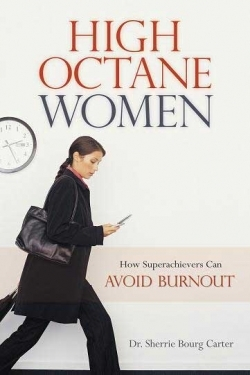High Octane Women
How Superachievers Can Avoid Burnout
Since the women’s movement of the 1960s, women have become increasingly successful in the workplace, reaching to new levels of influence and power in all areas of industry, law, medicine, and government. Yet, these achievements have led to new problems, thanks to the ever-increasing demands of the workplace and societal pressures unique to women. It’s not just women in “extreme jobs” who are facing this crisis, but all high-achieving women who psychologist Dr. Sherrie Bourg Carter identifies according to their ambitious mental approach to work, rather than by their workplace status. These women, the best and brightest of contributors, are doing such a good job that they are burning out.
Bourg Carter initially takes the reader on a well-researched tour of the pressures these women face, beginning with gender-based workplace stressors such as stereotypes, double-binds, and communication style differences. She goes on to elucidate the particular societal tensions women have wrestled over since the mid-twentieth century (“breadwinner vs. supporter” and “marriage/family vs. education/career”) and the effect they have on the lives of women who are trying to do it all. Thrown into the mix is a discussion of the impact of technological advancements—the blessings and curses—on achievement and productivity. But it is not all doom and gloom. With solutions in sight, Bourg Carter offers the high-octane woman some in-depth strategies for managing each of these stressors.
But what if a woman is already burned out—beyond the point of being helped by mere stress management? Not to worry: burnout is not a terminal disease, Bourg Carter argues, and women can recover from it if they will only take the appropriate steps. To this end, the author offers tools for self-assessment and survey of damage done as well as recovery steps, suggestions for stress relief, and a burnout prevention plan.
While High Octane Women is a must-read for superachieving women who are looking to manage unique and individualized reasons for burnout, an epilogue also points the finger at the workplace itself and identifies how dysfunctional structures are part of the problem. Employers and company CEOs looking to reduce workplace stress will be eager to read Bourg Carter’s prescriptions for change, which include innovative benefit programs that create low-stress infrastructures within which employees, and women in particular, might truly thrive.
Reviewed by
Heather Weber
Disclosure: This article is not an endorsement, but a review. The publisher of this book provided free copies of the book to have their book reviewed by a professional reviewer. No fee was paid by the publisher for this review. Foreword Reviews only recommends books that we love. Foreword Magazine, Inc. is disclosing this in accordance with the Federal Trade Commission’s 16 CFR, Part 255.

